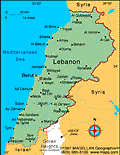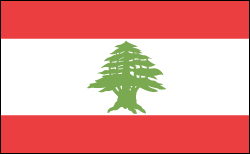Lebanon
| Facts & Figures | |
|---|---|
President: Michel Suleiman (2008)
Prime Minister: Najib Mikati (2011)
Land area: 3,950 sq mi (10,230 sq km);total area: 4,015 sq mi (10,400 sq km)
Population (2010 est.): 4,125,247 (growth rate: 0.6%); birth rate: 15.1/1000; infant mortality rate: 16.4/1000; life expectancy: 74.8; density per sq km: 388
Capital and largest city (2003 est.):Beirut, 1,916,100 (metro. area), 1,171,000 (city proper)
Other large cities: Tripoli, 212,900; Sidon, 149,000
Monetary unit: Lebanese pound
|
| |
Geography
Lebanon lies at the eastern end of the Mediterranean Sea, north of Israel and west of Syria. It is four-fifths the size of Connecticut. The Lebanon Mountains, which run parallel to the western coast, cover most of the country, while on the eastern border is the Anti-Lebanon range. Between the two lies the Bekaa Valley, the principal agricultural area.
Government
Republic.
History
After World War I, France was given a League of Nations mandate over Lebanon and its neighbor Syria, which together had previously been a single political unit in the Ottoman Empire. France divided them in 1920 into separate colonial administrations, drawing a border that separated mostly Muslim Syria from the kaleidoscope of religious communities in Lebanon, where Maronite Christians were then dominant. After 20 years of the French mandate regime, Lebanon's independence was proclaimed on Nov. 26, 1941, but full independence came in stages. Under an agreement between representatives of Lebanon and the French National Committee of Liberation, most of the powers exercised by France were transferred to the Lebanese government on Jan. 1, 1944. The evacuation of French troops was completed in 1946.
According to the unwritten National Pact, different religious communities were represented in the government by a Maronite Christian president, a Sunni Muslim prime minister, and a Shiite national assembly speaker. This arrangement worked for two decades.
Civil war broke out in 1958, with Muslim factions led by Kamal Jumblat and Saeb Salam rising in insurrection against the Lebanese government headed by President Camille Chamoun, a Maronite Christian favoring close ties to the West. At Chamoun's request, President Eisenhower, on July 15, sent U.S. troops to reestablish the government's authority.


No comments:
Post a Comment